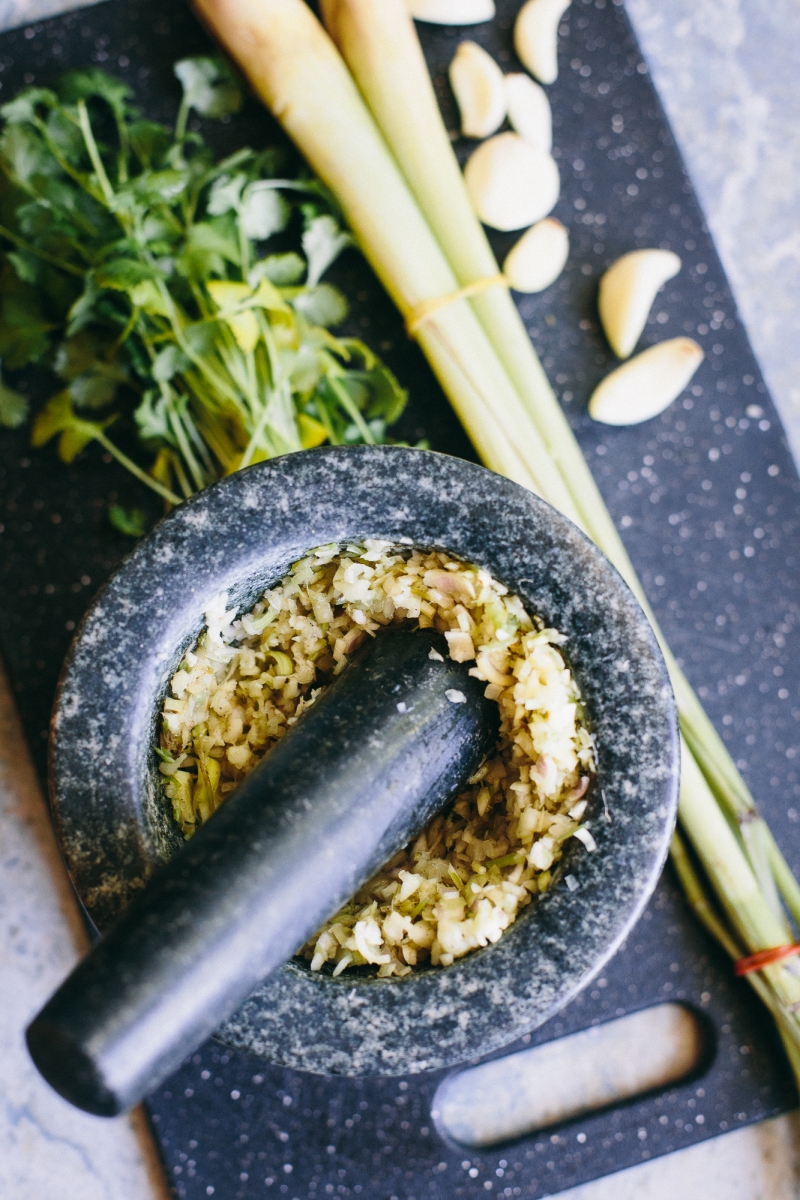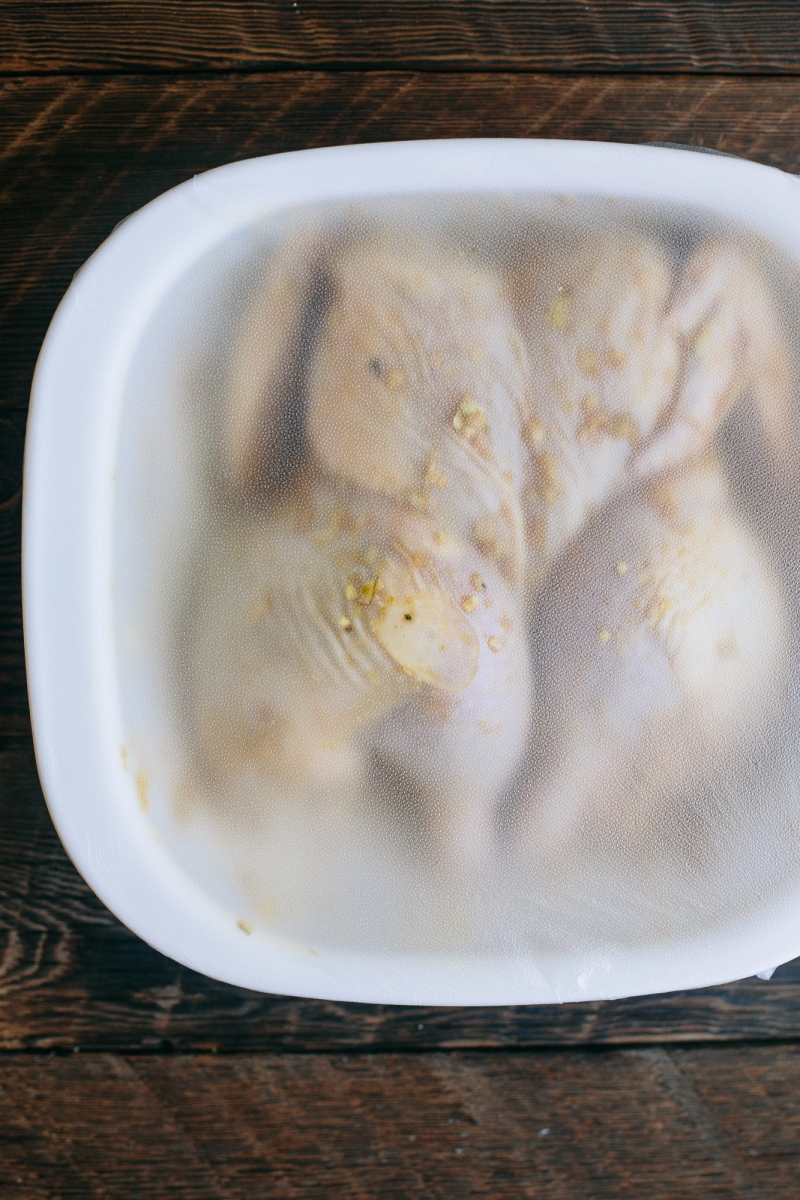
Gai Yang (ไก่ย่าง, sometimes spelled Kai Yang) is a barbecue grilled chicken recipe originally from Laos, but most commonly associated with Thailand today; it is a popular street food often served alongside Green Papaya Salad and sticky rice.
This dish is quickly becoming a favorite at our house because it is super simple to put together and all of the ingredients are relatively easy to find – only one ingredient (lemongrass) isn’t available in our everyday grocery store. Luckily, we keep chopped lemongrass in our freezer, and if that runs out, our local Asian market is only a few minutes away.
I enjoy preparing this dish because it gives me an opportunity to roll up my sleeves and get physical with its preparation – by spatchcocking the chicken, pounding some ingredients in a mortar and pestle, and finally chopping the entire bird up with a cleaver at the end.

Cilantro (aka coriander) roots are one of the key ingredients in this recipe. While it’s hard to find them for sale in the US, there is an easy solution – simply buy one of those potted cilantro plants that are typically sold in most grocery stores, then take the plant out of the soil when you get home. You’ll be surprised to find that most of these potted plants cost only a dollar or two more than the fresh herbs in the produce section anyway. The leftover soil goes in the garden, the plastic container is reused for other projects or tossed in the recycling bin.
For this recipe, I use both the roots and the stems – basically everything up until I reach the leaves.
Gai Yang - Thai Grilled Chicken (Gluten-free, Perfect Health Diet, Paleo, Primal, Whole30-friendly)
1 whole chicken (3-4 lbs)
1 stalk lemongrass, white part only, thinly sliced
20 cloves garlic, coarsely chopped
roots and stems of one bunch cilantro
1/2 tsp salt
1/2 tsp white pepper
1/4 tsp ground turmeric
1 tbsp lime juice
1 tbsp tamari (or coconut aminos)
1 tbsp fish sauce
For the sauce: (optional, see #3 below)
1 stalk lemongrass, white part only, thinly sliced
3 cloves garlic, coarsely chopped
2 small chiles, coarsely chopped
1 tbsp tamarind paste (see note below)
1 tsp fish sauce
1 tsp lemon juice
1 tsp coconut palm sugar or honey
1 tsp avocado oil
salt to taste
1. Butterfly (aka spatchcock) the chicken – my friend Michelle at Nom Nom Paleo has a good guide here. Once it is butterflied, gently pound the chicken with your hand or the flat end of a meat tenderizer until it is of even thickness.
2. In a mortar, combine the lemongrass, garlic, and cilantro stems and roots; mash with a pestle until a textured paste, about 5 minutes. Combine with the remaining ingredients in a separate bowl and stir until uniform. Rub all over the chicken, front and back, then cover and refrigerate for at least 2 hours, overnight preferred.
3. The chicken is often served with a sweet and sour dipping sauce, accented by tamarind; the chicken is delicious with or without the sauce. To make it, combine the lemongrass and garlic in a mortar and mash with a pestle until it is a paste; add the remaining ingredients and stir to combine, then set aside.
4. Prepare your grill for indirect grilling by igniting the burners on only one side (gas grill) or by banking the coals to one side (charcoal grill). Place the chicken skin-side up on the cool side of the grill, reserving any marinade. Cover and grill over indirect medium-high heat (375F) until golden, about 60 minutes, brushing with the reserved marinade and turning to skin-side-down about 45 minutes into grilling.
5. Once the chicken is just about perfect, transfer it to the hot side of the grill, skin-side-up, until the bottom is slightly charred, about 2 minutes, then remove from the grill and rest for 10 minutes. Remove the drumsticks and wings then chop up the chicken using a cleaver or sharp knife – there is no wrong way to cut the chicken up, so have fun with it. I cut mine through the bone with a nice hefty cleaver, which was very therapeutic.
6. Serve with a salad, or fresh vegetables. I served mine with Do Choa (pickled carrots and daikon radish, recipe available in The Ancestral Table), but Green Papaya Salad is a common accompaniment (recipe in Paleo Takeout); at the end of the day, even something as simple as chopped carrots and tomato wedges would be excellent.
** Tamarind is most frequently sold in blocks of dried pulp, which is available in most Asian or Latin markets. To turn it into a paste, simply cut a piece of the block and combine with a little boiling water; once soft, run the pulp through a strainer to catch any chunks, and use the strained liquid.

Making the marinade. Using a mortar and pestle is one of my favorite pastimes (much more fun than long walks on the beach).

Marinating.

Before the cleaver.

This looks fantastic!
LikeLiked by 1 person
OMG, delicious!!
LikeLike
This looks really delicious AND I grow lemongrass in my vegetable garden so I’m all set. Really like the combination of flavours in this dish and it is so healthy and appetising. Salivating just thinking about it. Will be trying this one out for certain. Thanks for sharing. margaret
LikeLike
Beautifully done – I do wonder why you use the roots and stem of the cilantro and not the leaves? :)
LikeLike
Hi Linda, the roots have a woodier flavor than the stems and leaves, which lends to a distinct taste. I use stems too since they lend their own flavor and hold up better than leaves, which degrade quickly when mashed in the mortar and pestle.
LikeLiked by 1 person
Good to know! I love using cilantro but have yet to use their roots – Thanks Russ 😀
LikeLiked by 1 person
Great recipe. I tried it and my entire family loved it.
LikeLike
What if you dont have a mortar and pestle?
LikeLike
A food processor or blender will work! You may need to add water to get it to blend.
LikeLike
Thank you. I made this today in my oven. It wasnt as zesty as I thought it would be, the flavor was very mellow, but delicious. I paired it with sticky rice, perfect dinner.
LikeLike
looks delicious !!
LikeLike
definitely trying this over the weekend!
LikeLike